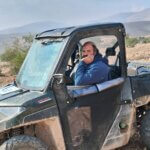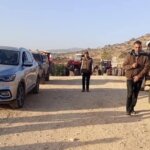Water for Fasayil Al-Wusta – Jordan Valley
In the eastern part of the Palestinian West Bank, stretched over 70km along the Jordan River, lies the Jordan Valley. To this day, agriculture is a major source of income for the valley[1]. These revenues are not generated anymore in the Palestinian villages, but in Israeli settlements. Chances are that the freshly cut mint, tarragon or sage you last bought in the supermarket were grown there. Agroindustry is flourishing in the settlements at the expense of Palestinian farmers, who’s access to water is being restricted more and more[2]. Jordan Valley Solidarity is a local organization with an international network working in solidarity with and for the Palestinian population in the Jordan Valley[3].
Israel occupied the West Bank since 1967 (Six Day War). The Jordan Valley was one of the first regions where Israel started the construction of settlements. Today there are 37 settlements in the Valley, where more than 9,000 settlers live. They live alongside the 29 villages and dozens of Bedouin communities where 65 000 Palestinians live. In the 90s, the West Bank was divided into zones A, B and C (Oslo Accords)[4]. 93% of the Jordan Valley was marked as ‘zone C’. This area came temporarily under full Israeli control. Zone A includes most urban parts of the West Bank and is under full control of the Palestinian Authority (PA). In Zone B, the PA responsible for civil affairs, Israel for security matters[5].
A village surrounded by settlements
Fasayil is one of 29 Palestinian villages in the Jordan Valley. It consists of three parts: Fasayil Al Techta (900 inhabitants, zone B), Fasayil Al Fauqa (750 inhabitants, Area C) and Fasayil Al Wusta (150 inhabitants, zone C). Formerly the village was surrounded by fields where among others dates, corn, melons, bananas, citrus fruits, tomatoes and potatoes were grown.
In the south Fasayil is completely enclosed by the Tomer settlement, in the north it runs along the border of Pez’ael settlement. The two settlements have taken most of the farmland in the area. Behind electric fences of three meters high green, abundantly irrigated fields are stretched out. Behind other fences stand newly built houses, with swimming pools and carports in the generous shade of tall green trees.
No agriculture without water
In Fasayil Al Wusta there is almost no direct access to water at the moment. Years ago various channels connected the fields around the village with the two sources of the village. One source is below the villagehouse, formerly the gathering place for the local farmers. The house is temporarily empty. The walls are cracked and birds have taken up residence in the kitchen. The source itself is almost completely dry. The second source, further away from the village, is about to collapse. Due to the poor state of the source the little water that’s still available is no longer suitable for human consumption. An application for a renovation permit at the Israeli Authorities was denied, and the villagers have not the courage nor the energy to start the work without it. The channels along the fields have been damaged in several places and at other completely disappeared.
Residents who can afford it let a tractor bring tankwater from a village where do have access. But the prices of this water are so high that it is only used for domestic use and as drinking water for the herds[6]. Many residents of Fasayil have little options left but to get a job in the Israeli agrobusiness in Tomer and Pez’ael settlements. They get no contract, insurance or prospect of job security, are poorly paid and also minors can get a job.
Water enough
The settlements Tomer and Pez’ael get their water mainly from Mekorot, the Israeli water company. In the Jordan Valley Mekorot installed 28 water pumping stations that pumped 32 million m³ in 2008. The amount of water that Israel pumped over the years from the reserves under the Jordan Valley (the Mountain Aquifer) was so high, that the water level dropped. Palestinian wells, that are usually less deep that Israelis, are drying up one by one. You can see the Mekorot pumping stations all over the Valley. They are white and blue painted pipes, each one enclosed with fences and barbed wire. Palestinians in area C rarely get access to this water and not get the permission to renovate or deepen their own wells. The vast network of pipelines that has been drawn from the pumps to the settlements sometimes goes right past or under Palestinian Communities[7].
Jordan Valley Solidarity
There are plans for Fasayil Al-Wusta. The local organization with an international network Jordan Valley Solidarity (JVS) works in solidarity with and for the local population. They keep in touch with the various communities and local and international volunteers to help with the renovation of houses, construction of water systems and to regularly report on the situation. In 2007, volunteers from JVS along with a delegation of students from the university of Sussex and Ma’an Development Center built the only school in Fasayil. In 2008 the school received a demolition order from the Israeli authorities, because it was built without a permit. There was a fierce campaign against the order, and for now the school is still there. It is home to some 200 students from 6 to 15 years. The construction of the school has encourabged several residents to get started with the renovation of their own home and not to wait for the necessary permits from the Israeli authorities. Israel continues with the demolition of houses and the issuing of demolition orders in all the West Bank[8].
After renovation the townhouse in Fasayil al-Wusta will become JVS’s new Meeting House, where international volunteers can sleep during their stay, and where new projects can take form. After today Fasayil al Wusta also has limited access to water again. Palestinian and international volunteers constructed a waterpipe of 600m of Fasayil all Fauqa to Fasayil al Wusta. The pipe provides for five families, and has a capacity of about 20m ³ per day.
References:
(1) Al Haq, ‘Feasting on the occupation’, 2013, p 11
(2) B’tselem, ‘Dispossession and Exploitation – Israels policy in de Jordan Valley and the Northern Dead Sea Area’, 2011, pg 7-8
(3) www.jordanvalleysolidarity.org
(4) Look at the map ‘jordan valley’ to see the partition of the west bank in areas A, B and C
(5) ‘Dispossession and Exploitation’, cfr 2
(6) The price of tank water per m³ is approximately 27 times the price of the tap water in Tubas. Prices vary according to the distance.
(7) ‘Dispossession and Exploitation’, pg 21, (cfr 2)
(8) For a weekly update on civilian injuries, casualties and material damage, see http://www.ochaopt.org/






